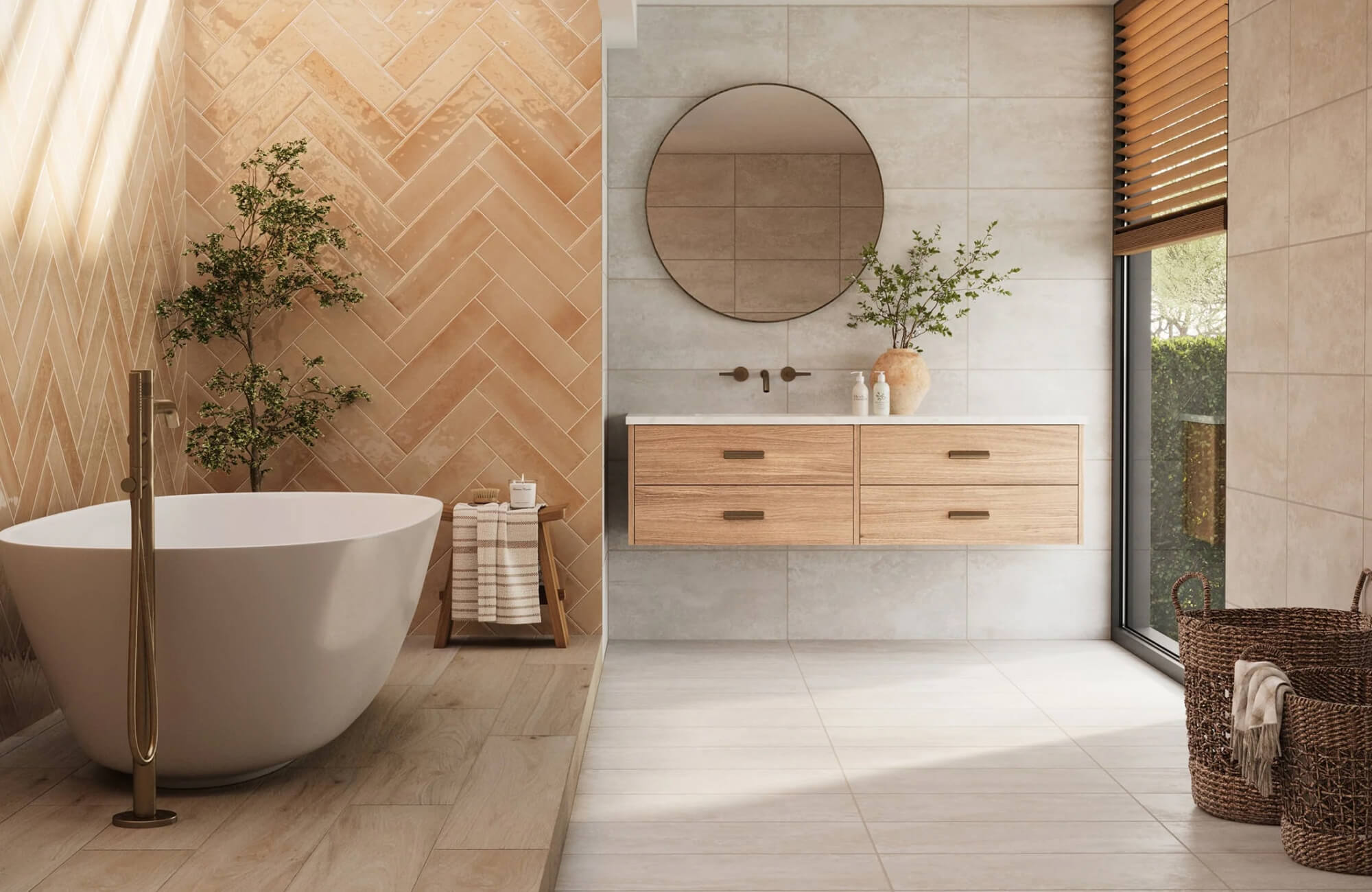Can the classic subway tile, long favored for walls, hold up underfoot? It's a question gaining traction among those seeking to repurpose this design staple beyond its traditional use. Yet, not every subway tile is built for the job. The key lies in understanding material composition, surface finish, and essential performance metrics such as PEI rating and slip resistance.
When applied thoughtfully, subway tiles can bring both function and flair to flooring. That said, achieving the right balance of style and durability requires more than just visual appeal. In this article, we’ll unpack what it takes to use subway tiles successfully on floors, covering everything from technical guidelines and material considerations to design strategies and ideal application scenarios.
Understanding Subway Tiles’ Composition and Characteristics
Before deciding if subway tiles belong on your floor, it’s important to understand what they’re made of and how their size and shape affect performance. After all, not every tile that looks good on a wall is built to handle the wear and tear of daily footfall.
Material Variations Impacting Floor Suitability
Subway tiles are typically made from ceramic or porcelain, each offering different performance traits. To start, ceramic subway tiles, often used on walls, are kiln-fired at lower temperatures, resulting in a softer, more porous structure that’s not ideal for active flooring. Their smooth, glossy glazes can also become slippery when wet, increasing the risk of accidents.
In contrast, porcelain subway tiles are denser and less porous due to their refined clay and higher firing temperature. These qualities allow them to meet PEI ratings of 4 or 5 and maintain low water absorption rates, making them suitable for both residential and commercial floors, particularly in damp areas like bathrooms or entryways. It's also important to verify that the tile meets a wet DCOF rating of at least 0.42, by ANSI A326.3, to ensure adequate slip resistance.
Size and Shape Considerations for Flooring
Equally important is the format of the tile, which directly impacts both aesthetics and installation complexity. Subway tiles are known for their rectangular shape, commonly available in sizes like 3”x6”, 4”x8”, or 2”x8”. While their format works beautifully on walls, it introduces some challenges on floors. Smaller tiles can also suit compact areas like powder rooms but require precise installation and generate more grout joints, which may affect maintenance and traction.
Meanwhile, elongated formats such as 4”x12” or 6”x18” provide a modern look but require careful handling to avoid lippage, especially when installed with a 50% offset. To mitigate this, a 1/3 offset or stacked layout is often recommended, along with a leveling system. Furthermore, choosing rectified tiles, which have mechanically cut edges for uniform sizing, can also support tighter grout joints and a cleaner, more refined finish.

The Pros of Using Subway Tiles on Floors
While subway tiles may not be the first choice that comes to mind for flooring, they offer a surprising number of advantages when used in the right context. From visual appeal to everyday functionality, these benefits make a strong case for thinking beyond the backsplash.
Aesthetic Versatility
Subway tiles feature a historic, rectangular format that has endured since the early 20th century. Their clean geometry complements a wide range of interior styles, from classic to modern, and lends visual rhythm to floors, especially in narrow or open-concept areas.
In terms of layout, designers often turn to patterns like herringbone, basketweave, or stacked bond to introduce subtle movement or bold accents. For example, Edward Martin’s Marsden 3x10 Matte Ceramic Tile in Almond, as shown in the photo above, adds warmth and texture without losing the clean lines that define this tile style. With a range of finishes, from matte to satin, and a broad color palette, subway tiles can be tailored to suit virtually any aesthetic.
Cost-Effectiveness
In addition to their charm, subway tiles are also economical. These tiles are among the most budget-friendly options available, particularly in ceramic and porcelain. Their widespread availability and efficient manufacturing help keep material costs low, making them ideal for renovations or large-scale installs. Though porcelain may cost slightly more, it offers superior durability and is still more economical than many natural stone or designer tile alternatives.
Their manageable size also makes cutting and handling easier, which can streamline labor and shorten installation timelines. Many subway tiles are available pre-mounted on mesh sheets, simplifying complex layouts and helping reduce installation time and cost. Their long-term resilience further enhances value, minimizing replacement and upkeep needs.
Practical Benefits
Functionally, modern subway tiles, especially textured or matte porcelain, meet key performance standards for flooring. Tiles that meet the recommended DCOF rating, as mentioned earlier, are suitable for wet interior areas like bathrooms and mudrooms. Some options also include grip-enhanced glazes or micro-textures for added safety.
Maintenance is another win. Their non-porous surfaces resist moisture and stains, and unlike natural stone, they don’t require sealing. Cleaning is also simple; typically, a neutral pH tile cleaner and water are all you need to maintain the surface. Plus, the modular format makes it easy to replace individual tiles without affecting the whole floor. When paired with epoxy or stain-resistant grout, subway tile floors remain clean and durable with minimal effort.

The Cons and Challenges of Using Subway Tiles on Floors
Despite their charm and versatility, subway tiles aren’t a one-size-fits-all solution, especially when it comes to flooring. To make an informed choice, it's important to weigh a few practical drawbacks that could affect both the look and feel of your space.
Design Limitations
One key challenge is scale. Standard subway tile sizes like 3”x6” or 4”x8”, originally designed for walls, can feel visually cluttered on expansive floors. The numerous grout lines may disrupt the flow of open-concept spaces, especially compared to larger-format tiles that create a cleaner look.
While patterns like herringbone or basketweave add character in compact areas, they may overwhelm larger rooms or clash with existing design elements. To better suit floor applications, some opt for larger subway formats such as 4”x12” or 6”x18”, though these require careful leveling and layout to avoid lippage and warping.
However, when used creatively, the unique scale of subway tiles allows for personalized patterns that stand out in smaller areas. Their modular nature opens up more design possibilities that larger tiles simply can’t achieve.
Grout Line Maintenance
The smaller format of subway tiles also means more grout joints, which increases both visual complexity and maintenance needs. Additionally, grout is porous and prone to staining or mildew without proper sealing, especially in damp or busy areas like bathrooms and mudrooms.
To maintain appearance and durability, you must either commit to routine sealing of cementitious grout or choose more resistant alternatives like epoxy or urethane, which can be harder to install. Opting for narrow grout joints (1/16”–1/8”) can reduce visual clutter, but doing so demands greater installation precision. For instance, Edward Martin’s Marsden 3x10 Matte Ceramic Tile in Sand, as featured in the image above, offers an elegant look, yet highlights the importance of ongoing grout upkeep for lasting results.
Yet, these additional grout lines can enhance slip resistance and increase visual texture. With modern grout options and smart color choices, they become a valuable tool for adding both safety and style.
Comfort Underfoot
Finally, subway tiles, like all ceramic and porcelain options, are hard and unyielding, offering little in terms of comfort or insulation. In high-use areas such as kitchens or laundry rooms, prolonged standing on hard tile can lead to foot and joint fatigue.
Additionally, they retain cold, which can make floors uncomfortable in basements or cooler climates unless paired with radiant heating, a costly upgrade. Substrate prep is also critical, as these tiles require a flat, stable surface to avoid cracking, particularly given their brittle nature and small size tolerances.
However, this same hardness contributes to the tile’s incredible durability, making it a long-term flooring solution. When paired with cushioned mats or underfloor heating, you can balance comfort and resilience effectively.

Ideal Applications for Subway Tile Flooring
Subway tile flooring isn’t just about looks, it’s also about knowing where it works best. Depending on the space, these tiles can offer the perfect mix of durability, style, and practicality when thoughtfully placed.
Bathrooms
To start, bathrooms are one of the most suitable spaces for subway tile floors, especially when using porcelain options with a water absorption rate under 0.5% (per ASTM C373). Their non-porous, glazed surfaces help prevent moisture infiltration, making them ideal for areas like powder rooms, en suites, and showers. The compact format also increases grout coverage, enhancing slip resistance, a key benefit in wet areas.
Visually, subway tiles can unify walls and floors or introduce contrast through color and layout. For example, matte charcoal flooring with white wall tile offers depth without losing cohesion. A subway tile like our Chantel 12x15 Matte Porcelain Herringbone Mosaic Tile in Dolomite, as displayed in the picture above, can add elegant movement without overpowering the room.
For safety, ensure DCOF rating guidelines are met, and use epoxy grout to reduce moisture-related maintenance.
Entryways
Next, entryways and mudrooms demand materials that can withstand heavy footfall, dirt, and wear, an area where porcelain subway tiles perform well due to their high PEI rating and density. Their resilience makes them ideal for busy households, especially those with pets or kids.
Beyond durability, subway tiles offer design flexibility at the threshold of a home. Patterns like basketweave or chevron add personality without overwhelming the space. In regions with seasonal shifts, tiles rated for thermal stability and frost resistance can also be used in semi-outdoor applications. For added longevity, install with a latex-modified thin-set mortar to account for environmental changes.
Accent Floors or Smaller Spaces
Lastly, subway tiles truly shine in compact or secondary spaces, where their size and modularity allow for impactful, detailed designs. Areas like laundry rooms, breakfast nooks, or butler’s pantries benefit from thoughtful tile layouts that serve both form and function. Bold grout contrasts or creative patterns, like diagonal herringbone, can elevate these often-overlooked areas into stylish focal points.
To streamline the planning process, the Edward Martin Augmented Reality (AR) Visualization Tool lets you preview tiles in your space before committing. Just tap “View in Your Space” to experiment with patterns, colors, and orientation. Once you're confident in your choice, you can easily order real tile samples to verify tone and texture in person.

Essential Installation Considerations for Subway Tile Floors
Laying subway tile on the floor isn’t just about choosing the right style; it’s about getting the technical details right from the ground up. From prep work to finishing touches, each step significantly influences how your floor looks, feels, and holds up over time.
Subfloor Preparation
To begin with, a stable subfloor is essential for preventing cracks and lippage. Since ceramic and porcelain subway tiles are rigid and brittle, the substrate must be flat, dry, clean, and structurally sound. Deflection should not exceed L/360 for ceramic or L/720 for porcelain, as per TCNA guidelines.
For plywood, include an uncoupling membrane or cement backer board to manage movement and moisture. For concrete, ensure the surface is free from curing agents. In areas prone to shifting or vapor, systems like DITRA® or RedGard® offer additional protection. Uneven surfaces should also be corrected with a self-leveling underlayment (SLU), especially for patterns like herringbone that require tight tolerances.
Adhesive Selection
Once the subfloor is prepared, the next step is selecting the appropriate mortar for your tile and environment. For most porcelain subway tiles, use a polymer-modified thin-set mortar for strength, flexibility, and moisture resistance. Products like LATICRETE® 253 Gold and MAPEI® Ultraflex 2 are designed for demanding installations.
When working with impervious porcelain, select a mortar rated accordingly. For instance, larger tiles require a medium-bed mortar to help ensure even support. On the other hand, complex layouts like mosaics benefit from extended open-time mortars, allowing for careful placement. Use an appropriate notched trowel, typically ¼” x ⅜”, to ensure full coverage and avoid voids under the tile.
Grout Selection
Grout is a key factor in durability and visual appeal. For that reason, epoxy grout is ideal for high-moisture or busy areas due to its stain resistance and low absorption. Though trickier to apply, it offers long-term performance.
For traditional cementitious grout, opt for sanded grout (⅛” or wider joints) or unsanded (narrow joints), and always seal after curing. Urethane and hybrid grouts offer easier application with added water resistance. Grout color can also blend subtly or provide contrast to highlight patterns. For example, Edward Martin’s Olivia 4x16 Glossy Ceramic Tile in Cotto pairs well with both tonal and bold grout choices. Remember, use grout release on textured surfaces to ease cleanup.
Sealing Tiles and Grout
Finally, when it comes to sealing, most glazed tiles don’t require additional protection. However, unglazed or stone look tiles benefit greatly from penetrating sealers that protect without altering appearance.
For grout, impregnating sealers block stains while allowing breathability. These should be applied once the grout has fully cured (usually after 72 hours), and reapplication is recommended every 1–3 years based on wear. Epoxy grout typically doesn't require sealing, but always check manufacturer recommendations for compatibility.
For added visual depth and protection, especially in busy areas like kitchens and mudrooms, a sealer-enhancer can also be applied to enrich grout color and add a subtle sheen. With all that said, for best results and long-term performance, it's always recommended to hire a qualified professional for installation.
When and Why to Floor with Subway Tile
Subway tiles, originally designed for wall applications, have become an increasingly practical and attractive option for flooring. This shift is made possible by advancements in materials, particularly porcelain, which offers the strength, durability, and water resistance required for busy or moisture-prone areas. When selected with care and installed correctly, subway tiles can meet essential performance criteria such as PEI ratings for surface hardness, DCOF for slip resistance, and stability through proper subfloor preparation. These qualities make them suitable for spaces like bathrooms, entryways, and laundry rooms.
In addition to their functional benefits, subway tiles bring a timeless and adaptable design aesthetic. Their classic rectangular shape and wide range of sizes, finishes, and layout patterns allow for creative expression while maintaining a clean, structured appearance. They are cost-effective, easy to maintain, and versatile enough to complement both traditional and modern interiors. With thoughtful planning and quality materials, subway tiles can offer both elegance and reliability as a long-term flooring solution.








